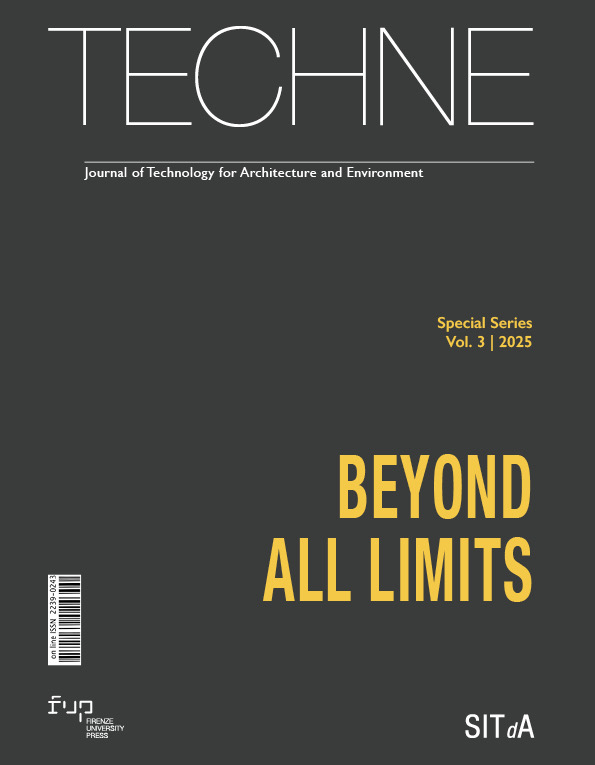Published 2025-07-31
Keywords
- Spatial Design,
- Service Design,
- Temporary Student Housing,
- Urban Renovation,
- Adaptive Reuse
How to Cite
Copyright (c) 2025 Luisa Collina, Laura Galluzzo, Elisa Cinelli, Claudia Mastrantoni

This work is licensed under a Creative Commons Attribution 4.0 International License.
Abstract
This essay explores the role of temporary student housing in urban regeneration and territorial revitalisation, focusing on adaptive reuse of abandoned buildings and underused spaces. It examines a feasibility study of a project in Lentate sul Seveso, Italy, where a former military park is being transformed into student housing and community spaces with funding from Italy’s National Recovery and Resilience Plan (PNRR). The essay highlights the potential of temporary housing to foster economic, social, and cultural revitalisation, while addressing student housing needs. It also underscores the critical role of universities in collaborating with local municipalities and communities to design inclusive, sustainable solutions for long-term urban recovery.
Downloads
References
- Bellini, O.E., Bellintani, S., Ciaramella, A. and Gatto, M.L.D. (2015), Learning and living. Abitare lo Student Housing, FrancoAngeli, Milano.
- Bellini, O.E., Gambaro, M. and Mocchi, M. (2020), “Living and learning: A new identity for student housing in city suburbs”, in Della Torre, S., Cattaneo, S., Lenzi, C. and Zanelli, A. (Eds.), Regeneration of the Built Environment from a Circular Economy Perspective, Research for Development, Springer, Cham. Available at: https://doi.org/10.1007/978-3-030-33256-3_11 (Accessed on 03/04/2024). DOI: https://doi.org/10.1007/978-3-030-33256-3_11
- Bertoni, F.A. (2024), Student housing in Italy: Historical development and policy impact [Master’s thesis, Politecnico di Milano], PoliTESI Repository. Available at: https://hdl.handle.net/10589/227541 (Accessed on 03/04/2024).
- Bologna, R. (2022), “Student housing in architectural renovation and urban regeneration projects”, TECHNE: Journal of Technology for Architecture & Environment, No. 24, pp. 198–206. Available at: https://doi.org/10.36253/techne-12855 (Accessed on 03/04/2024). DOI: https://doi.org/10.36253/techne-12855
- Borin, A. (2022), “Temporary housing solutions in extra-urban contexts”, in Galluzzo, L. (Ed.), Con-temporary living. Unexpected housing solutions in public spaces, Maggioli Editore, Rimini, pp. 306–314.
- Bullen, P.A. and Love, P.E.D. (2011), “Adaptive reuse of heritage buildings”, Structural Survey, Vol. 29, No. 5, pp. 411–421. Available at: https://doi.org/10.1108/02630801111182439 (Accessed on 03/04/2024). DOI: https://doi.org/10.1108/02630801111182439
- Charbonneau, P., Johnson, L.C. and Andrey, J. (2006), “Characteristics of university student housing and implications for urban development in mid-sized cities”, Canadian Journal of Urban Research, Vol. 15, No. 2, pp. 278–300.
- Collina, L., Galluzzo, L., Mastrantoni, C. and Cinelli, E. (2022), “Sustainable recovery and urban public transformation of a former military park”, Beyond All Limits, pp. 158–163.
- De Clasca, J.R., Fenollosa, J. and Tersol, M. (2019), “Barcelona open to the sea”, Revista de Obras Publicas, Vol. 166, No. 3606, pp. 22–29.
- Fassi, D. (2020), “Campuses and the city”, in Fassi, D., Landoni, P., Piredda, F. and Salvadeo, P. (Eds.), Universities as Drivers of Social Innovation, Research for Development, Springer, Cham, pp. 15–27. Available at: https://doi.org/10.1007/978-3-030-31117-9_2 (Accessed on 03/04/2024). DOI: https://doi.org/10.1007/978-3-030-31117-9
- Gainsforth, S. and Peverini, M. (2022), “Residenze per studenti tra pubblico e privato”, in Casa e abitare nel PNRR. Analisi e prospettive, Caritas Italiana – Servizio Documentazione, pp. 33–41. Available at: https://archivio.caritas.it/materiali/Italia/qrrp/qrrp_num1_mar2022.pdf (Accessed on 03/04/2024).
- Galluzzo, L. (2022), Con-temporary living. Unexpected housing solutions in public spaces, Maggioli Editori, Rimini.
- Gwosc, C., Hauschildt, K., Wartenbergh-Cras, F. and Schirmer, H. (2021), Social and economic conditions of student life in Europe: Eurostudent VII 2018–2021 | Synopsis of indicators, wbv Media GmbH & Company KG. Available at: https://www.eurostudent.eu/download_files/documents/EUROSTUDENT_VII_Synopsis_of_Indicators.pdf (Accessed on 03/04/2024). DOI: https://doi.org/10.3278/6001920dw
- Honey-Rosés, J., Anguelovski, I., Chireh, V.K., Daher, C., van den Bosch, C.K., Litt, J.S., Mawani, V., McCall, M.K., Orellana, A., Oscilowicz, E., Sánchez, U., Senbel, M., Tan, X., Villagomez, E., Zapata, O. and Nieuwenhuijsen, M.J. (2020), “The impact of COVID-19 on public space: A review of the emerging questions”, Cities & Health, Vol. 5, Suppl. 1, pp. S263–S279. Available at: https://doi.org/10.1080/23748834.2020.1780074 (Accessed on 03/04/2024). DOI: https://doi.org/10.1080/23748834.2020.1780074
- Manzini, E. (2006), “Design, ethics and sustainability”, Guidelines for a Transition Phase, University of Art and Design Helsinki (June), pp. 9–15.
- McCormick, K., Anderberg, S., Coenen, L. and Neij, L. (2013), “Advancing sustainable urban transformation”, Journal of Cleaner Production, Vol. 50, pp. 1–11. Available at: https://doi.org/10.1016/j.jclepro.2013.01.003 (Accessed on 03/04/2024). DOI: https://doi.org/10.1016/j.jclepro.2013.01.003
- Norberg-Schulz, C. (2019), “Genius loci: Towards a phenomenology of architecture (1979)”, Historic Cities: Issues in Urban Conservation, Vol. 8.
- Searle, G. (2012), “The long-term urban impacts of the Sydney Olympic Games”, Australian Planner, Vol. 49, No. 3, pp. 195–202. Available at: https://doi.org/10.1080/07293682.2012.706960 (Accessed on 03/04/2024). DOI: https://doi.org/10.1080/07293682.2012.706960
- Stevens, N.J., Tavares, S.G. and Salmon, P.M. (2021), “The adaptive capacity of public space under COVID-19: Exploring urban design interventions through a sociotechnical‐systems approach”, Human Factors and Ergonomics in Manufacturing & Service Industries, Vol. 31, No. 4, pp. 333–348. Available at: https://doi.org/10.1002/hfm.20906 (Accessed on 03/04/2024). DOI: https://doi.org/10.1002/hfm.20906
- Twiss, J., Dickinson, J., Duma, S., Kleinman, T., Paulsen, H. and Rilveria, L. (2003), “Community gardens: Lessons learned from California Healthy Cities and Communities”, American Journal of Public Health, Vol. 93, No. 9, pp. 1435–1438. Available at: https://doi.org/10.2105/AJPH.93.9.1435 (Accessed on 03/04/2024). DOI: https://doi.org/10.2105/AJPH.93.9.1435






